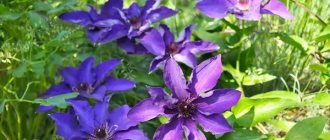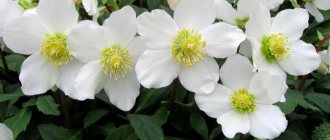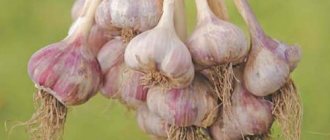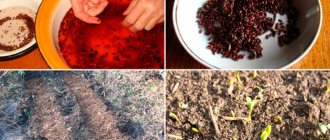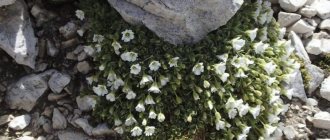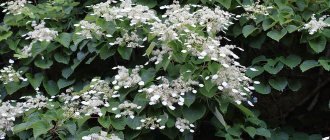Hydrangea Anabelle is the most common variety of tree hydrangea. This shrub will decorate any garden. During flowering, the plant looks very impressive and attracts attention. It is unpretentious in care, thanks to which it is successfully grown in different regions of our country. Even a novice amateur gardener can grow this beauty. In the article we will give recommendations for planting and caring for Anabelle hydrangea in open ground. Also in the publication you will find a photo and description of Anabelle hydrangea.
Description of the flower 2. Subtleties of planting 2.1. Selecting a location 2.2. Soil preparation 2.3. Planting dates 2.4. How to plant a plant 3. Caring for Anabel hydrangea 4. Flower propagation 4.1. Reproduction by division 4.2. Reproduction by layering 4.3. Propagation by cuttings 5. Diseases and pests 6. Plants in landscape design
Photo: Plants of this variety are unpretentious in care and will decorate any area with spreading white flowers.
Description of hydrangea Anabel
This is a lush flowering ornamental shrub. Natural habitat - Japan and China.
- In height, the spherical bush grows just over a meter. And it can grow more than three meters wide.
- The bark of the stems has a brownish-grayish tint.
- The leaves are dark green and can reach up to 20 cm in length.
- There are a lot of leaves, they are a “green cushion” for large flower caps.
- Flowering begins in June and lasts until October.
- Small white flowers are collected in large spherical inflorescences. The diameter of each flower is no more than 1.5 cm, and the diameter of the inflorescence can reach 25 cm.
- Has high winter hardiness. Can withstand frosts down to -35 degrees.
- It is successfully cultivated in Siberia and central Russia.
| Recommendation. Tree hydrangea is a long-liver in the garden. In one place it can grow up to 50 years. Therefore, carefully select a place to plant it, so that both it and you will be comfortable for many years! |
Photo: Hydrangea blooms from June to October.
Why doesn't it bloom
If the bush does not bloom, then there are reasons for this:
- shoots were pruned incorrectly in April;
- insufficient watering and nutrition;
- the roots of the plant are underdeveloped;
- Flowering was artificially stimulated in the nursery. Due to the addition of this kind of product, hydrangea may not bloom for years. To resume the flowering process, it is necessary to continue treatment with a growth stimulator;
- Tissue death occurred due to too severe frost.
But if the shrub is already blooming, then you need to know about the slight difference in the plant. Representatives of this variety can change the shade of flowering . To get this effect, you just need to add drugs that change the pH of the soil. By absorbing coloring elements, they spread throughout the tissues and affect the pigmentation of the petals.
Important! To get blue instead of white, you will need to add products that contain aluminum to the soil.
Features of planting hydrangea Anabel
Growing Anabelle hydrangea is not a labor-intensive process. But you need to know some nuances that will help you get the best decorative look for the plant.
Selecting a location
Before planting this shrub, choose a suitable place for it where it will receive the most favorable conditions for growth.
Loves semi-shaded places. The sun's rays should also fall on it, but not constantly. The scorching midday rays are especially dangerous for her. It is best to plant in a dense planting, where the hydrangea will be “covered” by other plants both below and above.
Like all hydrangeas, it is a water drinker. Loves moisture very much. Considering that it blooms profusely, this is an important point. If there is not enough moisture, then flowering will be scanty or there will be no flowering at all. Strong winds and constant drafts negatively affect the condition of the plant.
Choosing soil for a plant
It loves acidic soil, but also thrives on black soil. The soil should not contain lime and chalk. Does not like stagnant water. Therefore, when planting, be sure to add a layer of drainage to the bottom of the planting hole.
When to plant Anabelle hydrangea
Tree hydrangea seedlings Anabel with an open root system are planted in the spring - from April to May, or in the fall - before winter. The duration depends on the region and weather conditions. When planting before winter, you will need to cover the root part of the plant. Seedlings with a closed root system can be planted all summer.
| On a note. In the summer, you will need to water more intensively, apply artificial shading for a while while the bush takes root, and monitor the plant more carefully. |
Two to three year old seedlings are planted immediately in a permanent place. And younger specimens, grown from cuttings independently, can be grown in a schoolhouse or greenhouse.
How to plant hydrangea Anabelle
Planting a flower is quite simple.
- A planting hole of approximately 50x50x50 cm is dug.
- A drainage layer of at least 5–7 cm is poured onto the bottom. This can be expanded clay, crushed stone, broken brick.
- Add humus, sawdust, and sand to the excavated soil. I also add a little pine needles. It naturally acidifies the soil.
- When planting, do not deepen the root collar of the plant. We straighten the roots of the plant and carefully cover it with soil. If the seedling grew in a pot, then we try not to damage the roots, but plant it using the transshipment method, without disturbing the earthen ball.
| Note. If the roots are tightly entwined with the bottom of the pot and grow in a circle, then you can straighten them slightly. This will give the plant additional nutrition from the roots. |
- Lightly compact the soil after planting and be sure to water it abundantly - at least 1-2 buckets per bush. This depends on the age and size of the plant.
- Mulch the ground around the bush. You can put a small layer of pine needles on top of the ground. And already on it is the main layer of mulch. Mulch will help retain moisture in the soil longer and inhibit the growth of weeds.
If you do everything correctly, the Anabelle hydrangea quickly takes root and begins to grow actively.
Photo pixabay/Edyta1973: Follow the planting rules to grow a luxurious flower.
Diseases and pests and their control
Diseases:
- White rot. This type of fungus attacks the roots. Because of this, the hydrangea does not receive nutrients for nutrition, becomes coffee-colored and may die. An external sign is the appearance of a white coating on the branches. Without treatment, sclerotia, black pinpoint spots, appear. Fungicides such as Fitosporin will help defeat the fungus.
- Gray rot. Under its influence, plant tissues become soft and absorb liquid. As humidity increases, a gray edge forms. When dry, they dry out and die. You can overcome gray rot by cutting out some of the tissue that was damaged, and only then treat it with Rovral Flo 255 SC. It is necessary to process 3 times with an interval of 22 days.
- Septoria. This disease damages the leaves. Signs of damage are dark brown spots, 2–6 mm in diameter. If the plant is not treated, it becomes bald and dies. To combat the disease, all damaged parts are cut off, and the bush is sprayed with products that contain copper, for example, copper sulfate.
- Powdery mildew. First, yellow-green dots form, which then increase in size and change color to brown. A gray or purple coating is noticeable on the foliage. If the bush is not treated, the leaves fall off and the branches become deformed. The disease is treated with fungicides: “Fitosporin”, “Alirin”.
Pests:
- Leaf aphid. Colonies of pests suck out cell sap, without which the plant dries out and dies. If there are not many aphids, you can drive them away with a strong water jet or treat them with a soap solution. In severe forms, insecticides such as Fitoverm or Akarin are used.
- Spider mite. A sign of mite damage are yellow spots. In hot weather, it can cover a bush with cobwebs in a week. The result of the defeat is fallen leaves. If there are not so many cobwebs yet, then you can treat with a soap solution. If this does not help, then you should use insecticides such as Tiofos, Akarin.
- Slug. The pest eats the foliage of the bush. It can be defeated by “Molluscicide” granules, which are scattered over the surface of the soil.
Growing this variety of hydrangea requires patience and time, but it is worth it. It will refresh your garden and make it more tender. And you will never get tired of it, because thanks to its ability to change the shade of the inflorescence, hydrangea is always different.
Caring for Anabelle hydrangea in the open ground
During hot weather, abundant and constant watering should be provided. After watering, it is recommended to loosen the soil under the bush.
The shrub grows quickly, so timely and proper pruning is necessary. Without pruning, the plant will eventually go wild and produce small flowers. You need to prune early in the spring. Remove old, broken and growing shoots inside the bush.
By periodically feeding hydrangea with any complex fertilizers, you will get a lush flowering and healthy bush. You can also feed with a solution of potassium permanganate and a solution of citric acid.
| This is interesting! A distinctive feature of the Anabel hydrangea is that its flowers are always snow-white. You can give them a different color only artificially. There are special coloring agents. When watering with them, you can give the desired shade to part of the inflorescences or all the flowers. |
Shelter for the winter is not required. If the winter is snowless, then you can cover it with spruce branches and sprinkle the roots with peat and sawdust. It is recommended to insulate young plants for the winter.
Which place to choose
The description of Annabelle tree hydrangea states that the shrub does not tolerate constant swampy soil, cold and damp air. The plant requires a dry and well-ventilated place, but without constant exposure to strong and gusty winds.
Hydrangea Pink Annabelle - description of the variety and its cultivation in open ground
The best option would be an area where the bush is protected by a fence, house or outbuilding. The soil should have a stable moisture level with average values. Stagnant water near the root system can cause it to rot, so you should avoid planting hydrangeas in areas where moisture constantly collects.
Important! The lighting should be diffused, as direct sunlight burns the bushes. The best options include places where there is sun in the morning and evening hours, and partial shade from noon to evening.
Hydrangea as a hedge
Methods for propagating Anabel hydrangea
You can propagate Anabelle hydrangea in several ways:
- By cuttings.
- By layering.
- Dividing the bush.
Reproduction by dividing the bush
The fastest and easiest way to propagate hydrangeas. But there are several points here.
Firstly, hydrangea grows very strongly, forms many shoots and sometimes it is not easy to dig out a section without damaging the shoots, roots and foliage of the plant. It is most convenient to divide in spring or autumn, when the stems are bare.
Secondly, this propagation method damages the roots. They form open wounds that can become infected or infected. But most often everything goes well, and the plant quickly heals the damage received.
Reproduction by layering
Reproduction by layering and cuttings causes less damage to the plant. But it takes longer to take root. Annabelle is taking root, good if you do it right!
- The lower branches of the plant and their central parts are selected and buried in the ground.
- It is best to dig in in the spring, before the leaves bloom.
- The buried branches need to be pinned to the ground with metal wire bent in the shape of a hairpin.
- Sprinkle soil on top and water generously.
In the future, you need to keep them moist. It is best to mulch with grass. By autumn, the branches will take root, and they can be cut off from the mother bush and replanted.
Propagation by cuttings
Here is how propagation by cuttings is carried out:
- In early spring, in April, the upper parts of the plant are cut off. Cuttings are about 10–16 cm long.
- The lower cut is made obliquely. We dust it in the root and at an angle of 45 degrees, plant it in a greenhouse or seedling box with nutritious and loose soil.
- Water abundantly and maintain typical conditions until complete rooting.
- When the cuttings take root and begin to grow, we plant them in a schoolyard at a distance of 25–30 cm from each other and grow them until they are two years old.
- We plant it in a permanent place.
How to propagate hydrangea is up to everyone to choose for themselves. The cutting method produces the largest amount of planting material from one bush.
Photo pixabay/pixundfertig: There are three ways to propagate the plant.
The need for feeding
Some gardeners do not fertilize regularly. And the hydrangea develops and blooms well. But impressive sizes of bushes and flowering caps are not expected in this case.
Feeding during the season takes place in several stages.
- In early spring, before mulching the soil, fertilizer is applied under the roots for intensive growth. It should be dominated by microelements such as phosphorus, potassium and nitrogen.
- During the formation of inflorescences, a second feeding is carried out, based on the content of phosphorus and potassium.
- In spring, you can spray the plant 2-3 times with a solution of potassium permanganate. This increases the strength of the shoots, which is extremely necessary for hydrangea. Under the weight of the buds, the branches bend towards the ground.
Some try to tie branches to a support. But this action completely changes the greatness of the bush.
Using flowers in landscape design
This hydrangea is actively used to decorate public spaces and private gardens. This is the perfect tapeworm against the backdrop of an emerald lawn. And not just the lawn. An adult plant looks impressive against the background of a fence, wall or building.
It goes well with other plants in flower beds - both annuals and perennials. Hydrangea Anabelle can be used to create hedges and zone spaces.
We recommend using our tips for planting and caring for Anabelle hydrangea to get healthy and beautiful flowers.
_____________________________________________________________________ Read our other articles about hydrangeas: Lunar calendar for flowers for 2022 17 best varieties of paniculate hydrangea: names, descriptions and photos of beautiful flowers How to grow large-leaved hydrangea in the Middle Zone _____________________________________________________________________ What kind of care do you provide for Anabelle hydrangea? Share your experiences and tips with other gardeners in the comments.
Proper pruning
The tree hydrangea Anabel is beautiful, caring for it mainly involves proper pruning. This process must be approached responsibly. Improper pruning can completely destroy the beauty of the plant.
Young bushes should not be pruned until they are 4 years old. Starting from this period, branches need to be pruned in early spring. Cuts are made from the ends of the branches, retreating an average of 15 cm. Young shoots on an adult plant can be cut by a third. This is necessary for the formation of lush flowers. In the absence of pruning, the buds begin to become smaller over time.
